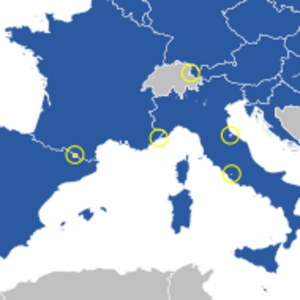Microstates and the European Union facts for kids
European microstates are very small countries in Europe. Even though they are tiny, they have special connections with the European Union (EU). The EU is a group of 27 countries in Europe that work together.
Five of these microstates are not part of the EU: Andorra, Liechtenstein, Monaco, San Marino, and Vatican City. Andorra is the largest of these five, with about 85,500 people in 2022. Two other small countries, Luxembourg and Malta, are full members of the EU. Luxembourg has over 600,000 people, and Malta has over 500,000.
Contents
How Microstates Connect with the EU
These small countries have different ways of working with the European Union. Their connections depend on their history and what agreements they have made.
Money Matters: The Euro
Many European microstates use the euro as their money. This is because they had special agreements with the EU. They were allowed to keep using the euro because they used currencies that were linked to it before.
- Andorra
- Monaco
- San Marino
- Vatican City
These countries can even make their own euro coins, but only a small number. Liechtenstein is different; it uses the Swiss franc instead of the euro.
Easy Travel: Border Rules
The Schengen Area is a zone where people can travel freely between countries without border checks. Many microstates are part of this area, or act like they are.
- Liechtenstein is a full member of the Schengen Agreement. This means people can travel between Liechtenstein and other Schengen countries easily.
- Monaco has an open border with France. This means France handles its border controls, so it feels like Monaco is part of the Schengen Area.
- San Marino and Vatican City are completely surrounded by Italy. They have open borders with Italy, so they are also de facto (in practice) part of the Schengen Area.
- Andorra does not have systematic border checks with the Schengen Area.
None of these microstates have big airports. They all have places for helicopters (heliports). Monaco is the only one with a seaport. The others are landlocked, meaning they are surrounded by land. If you arrive in Monaco from outside the Schengen Area, it is allowed. But you cannot do this in San Marino or Vatican City because they do not have their own border controls.
Trade and Laws: Economic Ties
Microstates also have different ways of trading and following EU laws.
- Monaco is part of the EU's customs territory. This means it follows the same trade rules as the EU, thanks to an agreement with France.
- San Marino and Andorra have a customs union with the EU. This means they do not charge taxes on goods traded between them and the EU.
- Liechtenstein is a member of the European Economic Area (EEA). The EEA lets countries be part of the European Single Market. This means Liechtenstein follows some EU laws related to trade and business.
All these microstates are also part of other important groups. For example, they are members of the Council of Europe (except Vatican City) and the Organization for Security and Co-operation in Europe. These groups help countries work together on human rights and security.
Other Countries and the EU
Sometimes, other countries that are not microstates consider joining the EU.
- Iceland is a country that is part of the EEA, like Liechtenstein. Iceland once applied to join the EU. If it had joined, it would have been the smallest EU country by population. However, Iceland decided to stop its application in 2015.
- San Marino also thought about joining the EEA. In 2013, people in San Marino voted on whether to apply for EU membership. Most people who voted said yes. But not enough people voted for the result to count.
See also
 In Spanish: Relaciones Unión Europea-micro-Estados europeos para niños
In Spanish: Relaciones Unión Europea-micro-Estados europeos para niños
- European microstates
- Foreign relations of the European Union
- Potential enlargement of the European Union
- Special member state territories and the European Union


